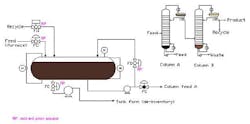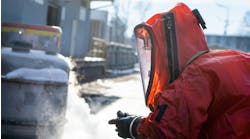THIS MONTH'S PUZZLER
We had to do a hot-tap on the top of an atmospheric tank containing crude triethylamine (boiling point: 50°C). As an extra safeguard, the approved job plan required diverting the tank's nitrogen blanket to an upper nozzle because our safety department deemed the area on top of the tank partially enclosed. Nitrogen was bubbled through a 4-ft-dia. polyethylene tank containing an aqueous 10% HCl solution; waste product overflowed the tank into a long grated drain in an area with a 6-in. dike. One side of the diked area is partially open to allow vehicle access. Plans called for scaffold erection on the first day, welding on the second day (weather-permitting) and scaffold removal on the third day. Ambient temperatures were in the mid-80°Fs. Sniff tests were performed on a periodic schedule around the work area at the top of the scaffold. A few hours into the welding, a small fire erupted several yards outside of the diked area. The safety department is investigating the accident. What do you think caused it? Is there a better way to do this welding?
LIMESTONE MAY BE THE CULPRIT
I suggest limestone contacted the overflow of the polyethylene tank, neutralizing the triethylamine hydrochloride to calcium chloride and triethylamine. Triethylamine, now free to be a vapor then caused the fire. I suggest the diversion of the nitrogen blanket was an unneeded complication. Triethylamine has an upper flammable limit (UFL) of 8%. Eight percent of 760 mm Hg = 61 mm Hg. Using Antoine's equation and constants listed in Lange's, at 79°F the vapors in the tank would be above the UFL. This is a second safeguard since the tank is inert padded with nitrogen. A proper hot-tap device could also be equipped with inerting nipples, eliminating air intrusion into the tank.
Mike Gentilcore, principal research engineer
Covidien Imaging Solutions, Hazelwood, Mo.
IT WASN'T NECESSARILY THE TORCH
I would guess that some triethylamine escaped from the tank and found its way into the dike. According to the MSDS I found, triethylamine is highly flammable, 3.48 times heavier than air, has a flash point of about 20°F, and an auto ignition temperature of 419°F. It's possible a spark from welding ignited the vapors if they were allowed to reach the mixture, but it could easily have ignited from any other ignition source or hot spot. With the information given, it doesn't seem that the welding itself had anything to do with the fire if it ignited several yards from the dike (assuming the ignition point was also several yards from the welding). I suspect the problem lies with improper control of the flammable material rather than the generation of an ignition source.
Pete Bisila, system reliability engineer - utilities
Flint Hills Resources, Hastings, Minn.
WHAT TESTING WAS DONE?
Sniff tests should have picked up an ignitable mixture but not if the liquid drained out of the work area. A number of questions come to mind. How was the acid concentration being maintained in the bubble column? Has this method been tested, preferably in the safety of a laboratory before risking operators? Did anyone calculate the amount of TEA potentially present in the vapor? Will a plastic tank hold up from the heat of solution with HCl-H2O and heat of reaction with TEA? Making a 10% solution of HCl by weight will produce enough heat to evaporate almost 10% of the water. Did anyone consider doing a new electrical area classification for the job plan?
Counting on operators to add acid every few hours is not a safe practice. A better approach would be to add a small acid tank and metering pump with a rheostat to adjust the flow. Inexpensive metering pumps can control to a few percent accuracy, which is more than adequate. It's crucial that the bubble column have a pH well below the pKa of the amine. Also, a cheap local pH alarm could suffice to avoid troubles. It might also be useful to establish a control link with the control room.
As for the bubble column design, consider a simple hillbilly solution: a brick tied to a mesh pad or bunch of plastic grating with polytetrafluoroethylene rope; anchor the hose connecting the tank nozzle to the bottom. This cheap improvement will increase bubble residence time.
The trouble with small dikes that are easy to step over is that they won't prevent flammable vapors from exiting a slit drain and becoming a fire hazard away from watchful eyes. Sniffing could easily miss fumes. They were probably focused on the welding and not the column.
Dirk Willard, senior process engineer
Middough Consultants, Holland, Ohio
JUNE'S PUZZLER
One of our board operators saw a spike in the level of a feed tank for a distillation process during a winter startup (Figure 1). She killed the fired heater feeding the tank. The fired-heater pressure relief valve blew ten minutes later. An hour after that, after the heater relief was isolated, a field operator looked at the tank pressure gauge and sight gauge. The level transmitter read 70% (compared to 65% before the incident). Later in the day when the board operator tried to de-inventory the tank, the pump cavitated. The field operator then noticed the position indicator on the pump suction valve showed it was closed; the other valves don't have position indicators. Can you explain what caused this series of problems?
Send us your comments, suggestions or solutions for this question by May 13, 2011. We'll include as many of them as possible in the June 2011 issue and all on CP.com. Send visuals — a sketch is fine. E-mail us at [email protected] or mail to Process Puzzler, Chemical Processing, 555 W. Pierce Road, Suite 301, Itasca, IL 60143. Fax: (630) 467-1120. Please include your name, title, location and company affiliation in the response.
And, of course, if you have a process problem you'd like to pose to our readers, send it along and we'll be pleased to consider it for publication.



